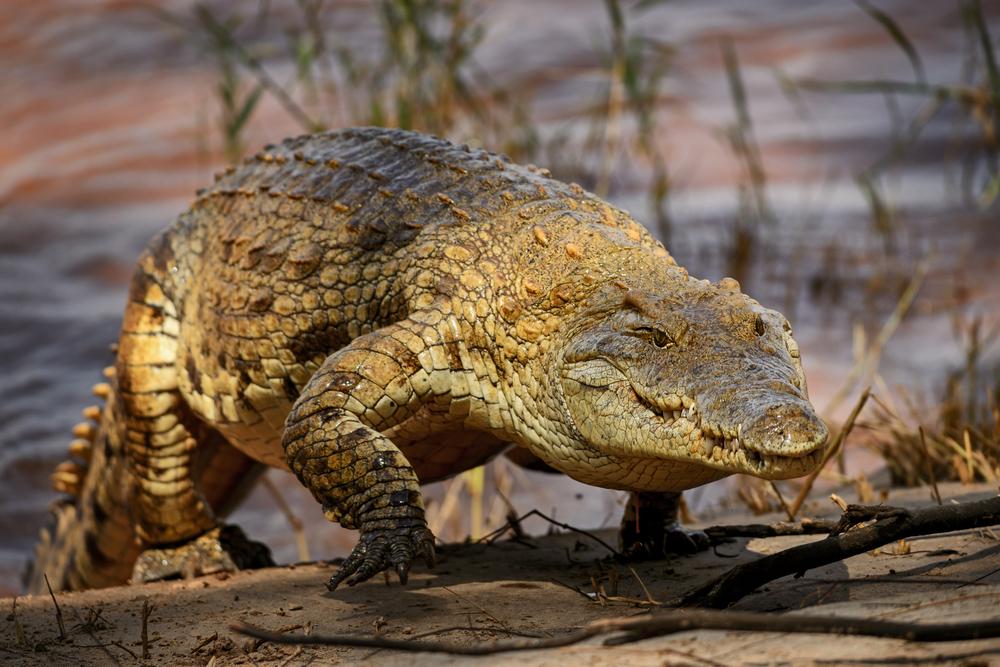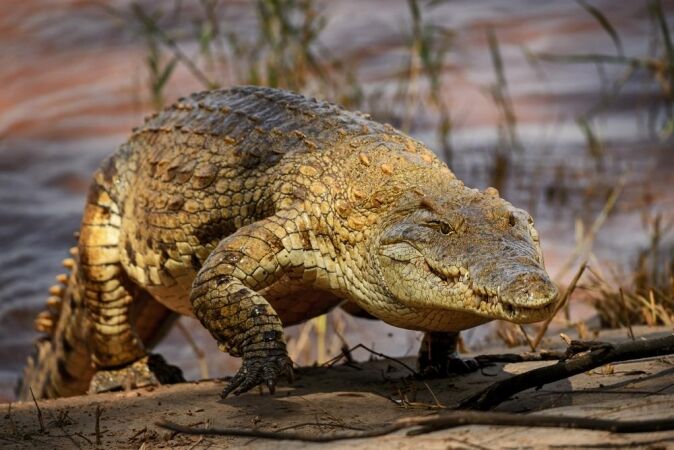

This prehistoric apex predator is a perfectly designed killing machine. With a tiny reptilian brain protected by thick bone, there is only one thing constantly on a crocodile’s mind: Death!
Sporting sharp teeth, powerful jaws, and a body wrapped in armor, there is no doubt as to why these giant lizards are one of Africa’s Dangerous 7 and a popular trophy when big game hunting in Africa.
The crocodile is an ambush predator. They are responsible for hundreds of human deaths every year and are encountered when hunting other big game animals that frequent or pass through the African waterways. Crocodiles are generalist feeders taking any prey that comes within attack range. No dangerous game hunting safari in Africa should exclude this tank of a beast!
When crocodile hunting in Africa, shot placement is critical. There is zero margin for error. Effective shot placement on a crocodile is one of the most stressful shots on any game hunting safari.
Any 30-caliber rifle with sufficient muzzle energy and a bullet meant for penetration will get the job done. A minimum of at least 180 grains bullet will suffice.
A little off-target and your crocodile will be gone into the depths, forever lost to the big game hunter! When considering shot placement on a crocodile, the hunter must remember that these predators often bask in the sun on the edge of the waterways.
What does this mean for the crocodile hunter?
A precision shot to the brain or heart may still result in the crocodile spasming and twitching. There is a good possibility that even though the crocodile is dead, the crocodile may still roll into the deep water.
Recovering the trophy crocodile in crocodile-infested waters would be rather interesting, to say the least! Who said a big game hunting safari for crocodiles would not be fun, stressful, and challenging?
An insurance shot to the spine to immobilize this ancient dinosaur would be strongly advised.
The crocodile is not to be underestimated as a hunting quarry. It senses the hunter approaching from afar because he has super senses. Crocodiles have sensory organs in the skin known as Dermal Pressure Receptors (DPRs) or integumentary sense organs. These are located on the upper and lower jaws and can detect changes and disturbances in water pressure. Crocodiles have similar sensory receptors on the rest of their body.
Crocodiles have good hearing and can sense sounds in and out of the water. They have a tympanic membrane on the side of the skull that conveys sound vibrations to the inner ear. Unique moveable ear flaps cover and protect them. Crocodiles can hear frequencies between 100–400 hertz.
Crocodiles have good eyesight and a broad visual range of 270°, with good vision to the side and front. They have a Harderian gland that produces oily tears. As this gland is constantly working, it seems as if the crocodile sheds tears when eating, hence the term crocodile tears.
What does this mean for the big game crocodile hunter and crocodile shot placement? The crocodile is going to be able to sense you coming! A successful stalk will result in a shot on a crocodile at a distance of around 50–100 yards.
When executing the frontal brain shot on a crocodile, the hunter needs to aim for the center of the skull, between the eyes and slightly above the nostrils. A successful frontal brain shot will result in a quick and humane kill.
The frontal brain shot, executed with precision on a crocodile, will be recommended by your professional hunter.
When taking the broadside brain shot on a crocodile, the hunter must aim for the small target located just behind the eyes and slightly above the center of the skull. Another way to describe this shot placement target area would be to aim above the smile and place the bullet just behind the eye.
The crocodile’s closed jaws create the “smile effect” which assists the hunter in identifying this target area. This “smile” is easily identifiable when the crocodile is broadside. Crocodiles have heavily armored skulls and powerful jaws. Avoid shooting directly at the jaws or the head, as this will miss the golf ball-sized brain.
When planning and preparing for the African game hunting safari, the hunter needs to practice and mentally prepare to consistently be able to hit this tiny and well-protected target at a range of 100 yards, as reptilian brains are small. If the hunter isn’t confident in his ability to make the shot, don’t bother packing and leaving on the game hunting safari, as crocodile hunting is not an option.
Effective crocodile brain shot placement is exceptionally difficult. If it were easy, everyone would do it!
When the crocodile lies broadside, the heart and lungs are well exposed and sit about two inches on the inside of the front leg. The hunter needs to consider the position of the front leg when executing this shot, as the heart is not always in the same position.
A lung shot, while fatal, will still result in the crocodile being able to move. When a crocodile is wounded, it will head straight for water. The possibility also exists that the crocodile gets stuck under an obstacle and will never surface.
The big game hunter must aim for the brain, found slightly above “the smile” and just behind the eye (center line of the skull). This brain shot is extremely challenging.
If a crocodile brain shot is not possible, a well-placed shot to the spinal cord located just behind the head is also effective. In some African hunting regions, this is the preferred shot that professional hunters recommend.
Aim for the region just above the neck where the spinal cord enters the skull. Crocodiles have thick, bony scales and a robust body structure. Avoid misdirecting the bullet at the shoulder bones or the heavy bony armor on the crocodile’s body, as these may deflect bullets and not ensure deep enough penetration.
Second and third reassurance shots should be fired in quick succession, following a well-placed first shot. When crocodile hunting in Africa and the hunter has a clear view from the broadside, the succession of shots must be delivered as follows:
1) The first bullet into the head penetrating the brain.
2) The second bullet into the spine, shattering the vertebrae.
3) The third bullet into the vital organs, heart and lungs.
These shots will leave the hunter with favorable odds of recovering the trophy.
Crocodile hunting often involves shots from a distance. Note the angle, trajectory, and bullet performance at the intended range. Ensure that your rifle and ammunition combination can deliver effective penetration. Do not attempt a crocodile hunting safari with an open-sight rifle. Wait for the RIGHT SHOT! Crocodile hunting in Africa requires a great deal of patience! Crocodile hunting requires the most precise shot placement. It is one of the trickiest and most difficult shots, but well worth it. As Erin Andrews once said, “The more difficult the journey, the sweeter the reward.”